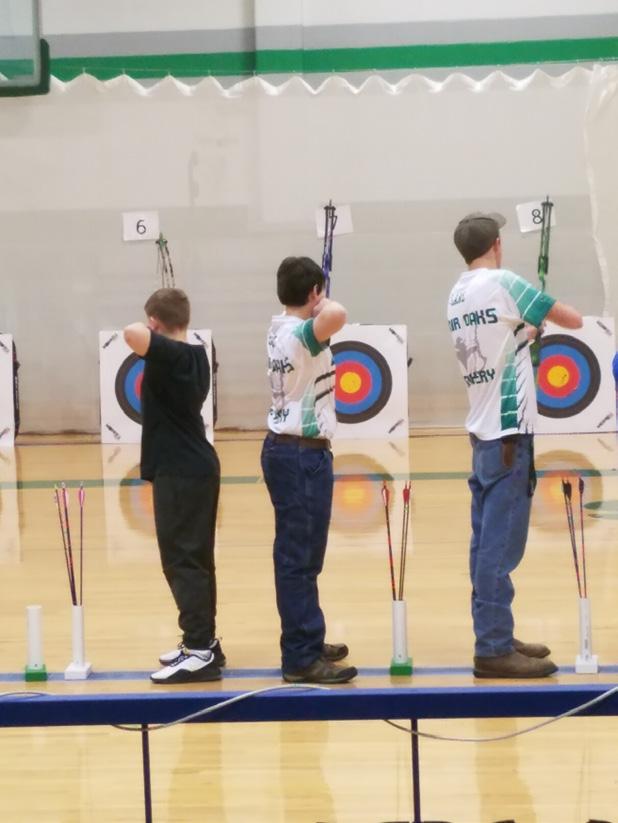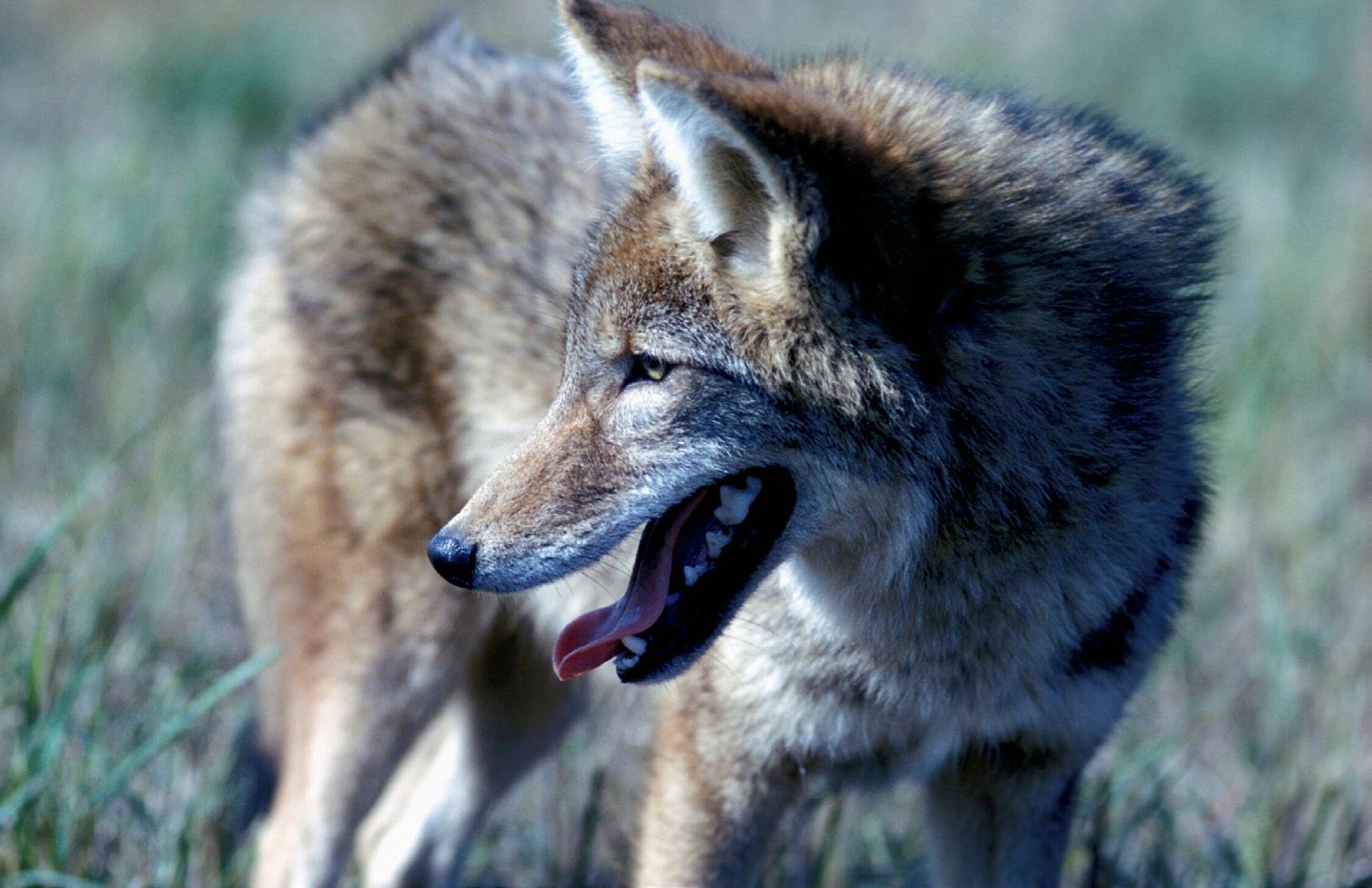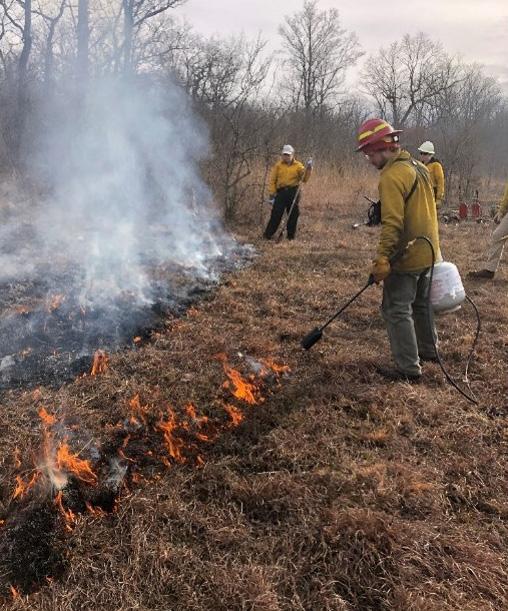
28 minute read
Missouri Trail Running
Whether it’s hot or cold, whether there’s rain or shine, you’ll find trail runners out scaling the rugged Missouri terrain year-round. The cool autumn months are ideal to lace up your shoes and give in to a new outdoor challenge. I spoke with Shalini Kovach, founder of the local trail/ultra running group Terrain Trail Runners, about ultra running and trail racing in Missouri, and her goals as a community organizer and race director for the future of the sport in Missouri. Trail running is not road running. There are rocks and roots, creeks and mud. Many runners start on roads and then move to trails for a bigger challenge, better scenery, and adventure. Trail runners pick up their feet and connect to nature through miles and miles of winding hills and forests.
How many miles? On average ultra runners can book anywhere between thirty and sixty miles per week for an annual total of 1,500 to 3,000 miles! This feat in human endurance is fueled by a love of the outdoors, a desire to experience what nature has to offer, and a strong sense of community among avid trail runners.
The trail running community is firstly supportive. “Most trail runners will reference the community as their trail family,” Kovach explained. “Each person who shows up to group runs or seasonal races becomes a small thread in the fabric of the large trail running community.” Activities like group runs, weekend adventures, and volunteering for trail work and trail building all solidify this sense of community among committed trail runners. “Once you run together, build trails together, and volunteer as a group you develop a deep rooted connection not only to the trails but also to the people in the community.”
Giving back is a priority for these trail users. Public lands are vital and stewardship of those recreational resources is an intrinsic community ethic. Runners invest hundreds of volunteer hours into trail maintenance and trail building each year in Missouri. Each Terrain Trail Runner event involves pre-race trail clearing and maintenance and post-race cleanup so every mile is left improved for the next user.
Want to give it a try and curious where to start? Greensfelder Park and Rockwoods Reservation in St. Louis County, and Rock Bridge Memorial State Park in Boone County are popular spots. In Missouri, trails are never very far and running groups can easily be found through social media. Kovach wants new runners to know Terrain Trail Runners is an open, supportive group of outdoor running enthusiasts. “The old school runners just want to lace up and run! New age trail runners want to over-plan every route, elevation, gear etc. At the end of the day both types of runners are equally important in shaping the community!” Trail running is a physical and mental challenge, there is a real sense of the unknown in each day, and the feeling of accomplishment comes from fully experiencing the varied terrain and dynamic outdoor conditions, wildlife, sounds, and scenery. Here are a few tips for safe adventuring. The best way to stay safe on trails is to run in a group, especially for long runs on remote trails. Make sure someone knows what area you are running in and what time to expect you back. Take a map to new trails and use a tracking app on your phone or watch if you have one. Some areas may require specialized equipment such as pepper or bear spray or a small air horn. Be mindful of hunting season. Avoid trails where hunting is allowed during deer rifle season and otherwise wear blaze. Trail running is technical. Slow down for sections with steep topography or loose footing, and think about how weather may affect trail conditions and creek crossings. Dress for the cold with hats, gloves, and layers, and have a headlamp to get in miles through the shorter winter days. When it’s really cold or icy, add traction devices to stay on your shoes and have some insulation around water to keep it from freezing.
As race director for Terrain Trail Runners, Kovach designs courses that give runners some of Missouri’s best scenery. She also embraces the rugged topography that can roll quickly from gentle hill slopes to steep climbs and really makes for a memorable day. Kovach would like to see her trail races recognized nationally as challenging events. “Personally, my focus is to break the generalization that all of the Midwest is flat. What the Midwest terrain lacks in climbs it makes up for in the rugged terrain which is challenging and opens up to some gorgeous bluffs and scenery that is underappreciated and overshadowed by the mountains and vistas of the West Coast.
Missouri itself has a plethora of state parks, conservation areas, and national forests that there is no lack of trails to explore whatever your choice of outdoor activity may be. I would like to continue in my volunteer efforts with trail maintenance and help build new trails in St. Louis and continue to advocate for trail events here in Missouri because our trails deserve the respect and appreciation nationally.”
Emily A. Sinnott
Many runners start on roads and then move to trails for a bigger challenge, better scenery, and adventure (Photo: Howie Stern)
CLC Fall Workshop - A Different Take
The Conservation Leadership Corps (CLC) Fall Workshop looked different this year. For the first time in the nearly 20 years of CLC, we were not able to meet in person. Over September 18-19, 2020, 32 students and 9 committee members got to know each other on screens that looked like the intro to the “Brady Bunch,” rather than the regular activity-filled retreat at Lake of the Ozark State Park. Nearly two thirds of those students are brand new to the CLC program.

The Youth Conservation Action (YCA) Committee met virtually many times in the months leading up to the Workshop to discuss the best ways to move forward considering COVID. Some of our students are not allowed to leave their college campuses and others could not attend in-person meetings with over 25 people in attendance. The YCA decided the best option for our students was to go virtual.
Going virtual presented us with a few challenges. The purpose of the CLC isn’t just to churn out resolutions, but to also create a conservation network for the students and committee members and introduce them to resource professionals throughout the state. Our major obstacle as a committee, was how do we create that camaraderie in a virtual setting?
It turns out, the CFM Young Professionals Committee had planned a virtual trivia night as a possible event for themselves. We thought, ‘what a fun way for students to get to know each other as part of a team!’ The virtual trivia was added to the CLC Fall Workshop agenda and was a great success! Judging from the student comments and review with the YCA committee, the virtual platform served us well for the overall event. “Even in tough times we can still all come together to complete are conservation goals,” one student said about the Workshop. After months of planning, we successfully adapted to the conditions before us and utilized the available tools. We added much to our virtual repertoire for engaging attendees and we are excited to see how this will help us in planning future events.
We will be working closely with Michelle Gabelsberger, Membership Development Coordinator, and the CFM affiliates to provide CLC students with local opportunities to volunteer and network with resource professionals. Volunteer events have included the Pull for Conservation: Central, a workday at Prairie Fork Conservation Area in Columbia, and the Pull for Conservation: Northwest in Hamilton. If you know of other conservation volunteer opportunities, please feel free to email me at czirkle@confedmo.org.
Stay Social!
Colton Zirkle
CFM Education and Communications Coordinator

Mission: To ensure conservation of Missouri’s wildlife and natural resources, and preservation of our state’s rich outdoor heritage through advocacy, education and partnerships.
In 1935, conservationists from all over Missouri came together to form the Conservation Federation of Missouri (CFM) with the purpose to take politics out of conservation. The efforts of our founders resulted in the creation of Missouri's non-partisan Conservation Commission and the Missouri Department of Conservation (MDC). Since then, CFM has been the leading advocate for the outdoors in Missouri.









Partnerships Over 100 affiliated organizations Share the Harvest Corporate & Business Partnerships State & Federal Agency Partnerships National Wildlife Federation Affiliate Operation Game Thief Operation Forest Arson David A. Risberg Memorial Grants Missouri Stream Team Education Conservation Leadership Corps Missouri Collegiate Conservation Alliance Confluence of Young Conservation Leaders Affiliate Summit Scholarships for youth and students Governor’s Youth Turkey Hunt National Archery in the Schools Grants Conservation Federation Magazine Advocacy Legislative Action Center Resolutions to lead change Natural Resource Advisory Committees Conservation Day at the Capitol Staff and members testify in hearings for conservation and natural resources
Conservation Federation of Missouri began
State Wildlife and Forestry Code published Wildlife and Forestry Act passed First turkey season in 23 years
Missouri Department of Natural Resources formed Operation game Thief formed Stream Teams formed Share the Harvest formed
Missouri voters renewed Parks and Soils Sales Tax by 70.8%
Outdoor Action Committee formed
CFM Celebrates 85 years
1935 1936 1940 1944 1946 1958 1960 1969 1974 1976 1982

1984 1989 1991 1992 2002 2006 2007 2009 2016 2020
Amendment 4 created Missouri's non-political Conservation Commission First deer season since 1937 First hunter safety program formed
Urban fishing program formed in St. Louis; first in the nation
Design for Conservation Sales Tax passed
Parks and Soils Sales Tax passed Operation Forest Arson formed Conservation Leadership Corps formed Missouri National Archery in the Schools Program formed Parks and Soils Sales Tax renewed by voters by the highest percentage to date (80%)
Ways You Can Support CFM
Membership Support our efforts to promote and protect conservation and natural resources in our state. Members will receive our magazine six times a year, event information, our bi-weekly enewsletter, and the opportunity to grow our voice. Affiliate Membership CFM provides the platform for a diverse group of organizations to have their conservation voices be heard. Affiliates have the opportunity to apply for grants, receive educational training and promote the mission of their organization. Scholarships and Grant Support CFM provides scholarships to graduates and undergraduates. We also provide grant funds to youth education programs and to affiliate projects. Contributing will help future generations initiate boots on the ground projects. Life Membership Become a life member for $1,000. Life memberships are placed in an endowment fund that allows us to continue our work in perpetuity.
Business Alliance Partnerships Business partners will enjoy recognition in each magazine issue along with opportunities to reach and engage with our active membership. Ask us about our different Business Alliance levels. Event Sponsorship and Product Donation All of our events have raffles with both silent and live auctions. The contributions of in-kind products and services not only assists in raising funds for conservation, but also promote the businesses that support CFM.
Conservation Federation of Missouri 728 West Main St, Jefferson City, MO 65101 Phone: (573) 634-2322 ~ Email: info@confedmo.org www.confedmo.org
Become a Member today!
Description Price Name:
Individual Supporter $35.00 E-mail: Individual Advocate $60.00 Phone: Individual Sustaining $100.00 Address: Youth/Student $20.00 Credit Card #: Individual Lifetime $1,000.00 Exp. Date:
Share The Harvest: It Matters Now More Than Ever
By the time you read this, Missouri's archery season will be well underway, and the regular firearms deer season will be almost upon us. I hope the current pandemic will not keep you from hunting if you had planned to. While my out-of-state travels have been curtailed, for the time being, I still can get to the Haverstick Homestead where I am trying to meet as many whitetails as I can, up close and personal. They all have a standing dinner invitation, and I hope that several of them will have taken me up on that by mid-January.
Having my hunting travels cut back is a first-world problem, as my daughter would say, and if that is the only thing I have to complain about, then I am truly blessed. The tumultuous times we currently find ourselves in have adversely affected many of our friends, family, and neighbors and food scarcity has become an issue for many folks who have never had to worry about that before. That's what makes the Share the Harvest program, and your participation in it, more important than ever. During the 2019-2020 season, Missouri hunters donated almost 6000 deer which totaled up close to 300,000 pounds of pure organic protein. That meat is gone almost as soon as it hits the food pantry shelves, and this season the need will be even more significant due to the high unemployment rate throughout the state. Please consider sharing some of your bounty with the less fortunate and, more importantly, try to recruit your hunting buddies to do the same.
Where I grew up, towards the Current River's headwaters, one of the primary industries is tourism. Those people are used to having a lean winter, but this year has been incredibly tough on them since winter started around the first of April. Fortunately, I know that any deer I donate to a local locker plant will stay right in that area and maybe even help out a friend that I didn't know needed the help. We Missourians are a proud bunch and asking for assistance goes against our nature. However, the need is there, especially now, even if it goes unspoken.

Donating meat to Share the Harvest program has never been more important than right now. (Photo: Courtesy of Darren Haverstick)
So what does this deer donation cost you? In a lot of cases, nothing. The Conservation Federation of Missouri is still covering the first $75 of the processing costs you incur for donating a whole deer and many local organizations will pick up the rest of the tab. All you have to do is call a participating meat processor, or the CFM office, to get the details.
With the governor's recent signature on HB 1711, the Share the Harvest program has been expanded to include shelf-stable venison for distribution. This is a huge deal because it gives the food pantries the ability to plan, months in advance, on how best to dole out that particular item. We plan to manufacture 2-packs of venison snack sticks and have those sent out to pantries across the state. We hope to incorporate these sticks into the after-school backpack programs to give children access to another protein source. There are still several logistical hurdles to overcome before this happens, but the STH committee is working hard to make this a reality.
Share the Harvest is a program that is nothing but a win for everyone involved. Please consider participating in something that makes such a difference in people's lives. 2020 has been rough on many folks, but you can help ease their suffering by donating now. Have a safe, fun, and hopefully productive season!
Darren Haverstick
Chairperson – CFM Share the Harvest Committee
MISSOURI DEPARTMENT OF CONSERVATION
MDC Updates Regulations Around Coyotes and Feral Hogs
The Missouri Department of Conservation (MDC) updated regulations to the Wildlife Code of Missouri regarding coyote hunting and feral hog control at its Sept. 4 Conservation Commission meeting in Jefferson City.
The change comes in response to citizen requests to the Regulations Committee to use night vision, infrared, thermal imagery equipment, or artificial light to hunt coyotes and from landowners to allow their authorized representatives to use night vision, infrared, or thermal imagery equipment without prior approval from a conservation agent to address damage caused by feral hogs.
The revised regulations allow landowners who own property of any size and their authorized representatives to possess, control, and use night vision, infrared, and thermal imagery equipment to kill feral hogs on the landowner’s property while in possession of any implement where wildlife could be killed or taken. Landowners and their representative would be authorized to kill or take feral hogs using these methods without prior approval from a conservation agent throughout the year.
The regulations also allow properly licensed hunters to use artificial light, night vision, infrared, or thermal imagery equipment in conjunction with other legal hunting methods to pursue and take coyotes from Feb. 1 through March 31.
The regulations become effective Nov. 30.

MDC notes that property owners and their representatives can still use night vision, infrared, thermal imaging equipment, or artificial light to kill coyotes or other wildlife causing property damage at any time of the year with written authorization from a conservation agent.
For more information on nuisance and problem species, visit the MDC website at https://short.mdc. mo.gov/Z5L.
MDC has updated regulations regarding the use of thermal imaging and night vision equipment to hunt coyotes and control feral hogs on private property.
Need Trees Or Shrubs for Your Landscaping?
Need trees and shrubs for your landscape? Go native with the Missouri Department of Conservation (MDC). Native trees and shrubs can help improve wildlife habitat and soil and water conservation while also improving the appearance and value of private property.
MDC’s George O. White State Forest Nursery near Licking offers a variety of low-cost native tree and shrub seedlings for reforestation, windbreaks, erosion control, wildlife food and cover, and other purposes. The nursery provides mainly one-year-old, bare-root seedlings with sizes varying by species. Seedlings varieties include: pine, bald cypress, cottonwood, black walnut, hickory, oak, pecan, persimmon, river birch, maple, willow, sycamore, blackberry, beautyberry, buttonbush, deciduous holly, hazelnut, redbud, ninebark, spicebush, elderberry, sumac, wild plum, witch hazel, and others.
Seedlings are available in bundles of 10 or increments of 25 per species. Prices range from 22 – 90 cents per seedling. Sales tax of 6.1 percent will be added to orders unless tax exempt. There is an $8 handling charge for each order. Receive a 15% discount up to $20 off seedling orders with a Heritage Card, Permit Card, or Conservation ID Number.
The nursery grows millions of seedlings each year, but some species are very popular and sell out quickly. Occasionally the seedlings succumb to uncooperative weather or hungry wildlife, despite the nursery staff’s best efforts.
“We had some late season cold weather this year, with nighttime lows in the 20s. Staff stayed up several nights in a row running the irrigation to keep the plants from freezing, but we still lost some. The hardest hit was a popular choice, the flowering dogwood,” said MDC Nursery Supervisor Mike Fiaoni. “I would encourage people not to wait when placing their orders.”
Fiaoni said that even if a species is listed as sold out, customers can still place an order for them. Sometimes orders get cancelled, freeing up inventory. Customers won’t be charged for seedlings unless they are available to ship.

Learn more and place orders through MDC’s “2020-2021 Seedling Order Form.” Find it in the September issue of the Missouri Conservationist, at MDC regional offices and nature centers, online at mdc.mo.gov/seedlings, or by contacting the State Forest Nursery at 573-674-3229 or StateForestNursery@mdc.mo.gov
Place orders now through April 15, 2021. Orders will be shipped or can be picked up at the nursery near Licking from February through May.
Buy natives trees and shrubs from MDC State Forest Nursery. Orders are being taken now through April 2021. Supplies are limited so order early.
MDC Sets Proposed Bear-hunting Framework for Future Seasons
The Missouri Conservation Commission recently approved a proposed hunting framework by the Missouri Department of Conservation (MDC) for a potential future black bear season in Missouri. The Commission approved the framework at its Sept. 4 open meeting in Jefferson City and is asking for final public input Oct. 16 through Nov. 14.

If the season framework is ultimately approved by the Commission and a permit and harvest quota is established, the earliest a season could occur is fall 2021 and would be limited to Missouri residents.
According to MDC, over the last 50 years bear numbers in the Missouri Ozarks have increased significantly and today Missouri is home to between 540 – 840 black bears. Missouri bear numbers are currently increasing each year by approximately 9%, bear range in the state is expanding, and Missouri’s bear population is expected to double in less than 10 years. Additionally, Missouri’s bear population is connected to a larger bear population in the surrounding states of Arkansas and Oklahoma.
“With Missouri’s growing black bear population, a limited and highly regulated black bear hunting season will be an essential part of population management in the future as Missouri’s bear numbers continue to grow,” said MDC Furbearer Biologist Laura Conlee. “The timing and length of the season, restrictive methods, and permit allocation coupled with a harvest quota will initially be limited to ensure a sustainable harvest of our growing bear population.”
Conlee noted that Arkansas and Oklahoma also have established bear hunting seasons.
Hunting Framework Details
Most of Missouri’s estimated 540-840 black bears are found south of the Missouri River, and primarily south of Interstate 44. With this in mind, MDC proposes to establish three Bear Management Zones (BMZ) in southern Missouri. The limited hunting season would begin each year on the third Monday in October and run for 10 days or until BMZ-specific quotas are reached, whichever comes first. Hunting hours would be a half-hour before sunrise to a half-hour hour after sunset. The proposal would limit black bear hunting to Missouri residents.
Harvest quotas for each of the three BMZs would be determined annually each spring by the Conservation Commission based on the recommendations by MDC. Quotas have not yet been established for the potential future season.
Once the specific harvest quotas are filled for each BMZ, the season for that BMZ would be closed. Hunters would need to call in before each morning they intend to hunt to determine if the BMZ-specific quota has been reached. If harvest quotas are not reached, the season would close at the end of the 10 designated hunting days.
Hunters would be allowed to use both archery and firearms equipment with allowable methods being the same as those for deer and elk, except the use of an atlatl. Baiting and the use of dogs would not be allowed at this time but may be considered in the future.
The harvest limit would be one bear per permit. Under the proposed regulations, bears may not be disturbed, pushed, harassed, or taken from a den. Only lone black bears may be taken. Hunters may not take bears that are known to be in the presence of others bears, including female black bears with cubs.
Bear hunters must wear hunter orange, make reasonable efforts to retrieve shot bears, and must use commonly edible portions.
All harvested bears would need to be telechecked by 10 p.m. on the day of harvest. Harvested bears would need to remain intact as a field-dressed carcass or quartered until the bear has been telechecked. MDC would also require the submission of a tooth from each harvested bear within 10 days of harvest. This would help MDC staff with black bear research and management.
Permit Process
MDC will offer an annual online permit-application period May 1-31 each spring with a fee of $10 per applicant. Individuals must be Missouri residents and would only be allowed to apply once per year to hunt in one of the three designated BMZs.
Permit selection would be determined by July 1 each summer through a random drawing of all eligible applicants. There would be no “sit-out” period for those selected to receive permits. There would be no preference points given, such as with managed deer hunts.
Those selected would be eligible to buy a permit at a cost of $25. A person would need to be 11 years of age or older and have completed hunter education (or be exempt) by the time of the hunt to purchase a permit.
MDC would issue a limited number of hunting permits for each of the three BMZs. Each permit would be for a specific BMZ and could be used on public or private property within the BMZ. There would not be a separate, landowner-specific black bear hunting permit.
Black bear hunting permits would be awarded through a random draw with a minimum of 10 percent reserved for qualifying landowners. To qualify for the landowner allocation, landowners would need have at least 20 contiguous acres within the BMZ for which they are applying. Qualifying landowners must first submit their property information through MDC’s Landowner Permit Application at mdc.mo.gov/landownerpermits before completing a black bear hunting permit application.
Public Comments
MDC proposed the limited and highly regulated hunting season framework for black bears following several years of public comment opportunities related to black bear management, including black bear informational open houses in 2019, and a public input process this spring to inform development of the proposed hunting season framework.
MDC is asking for final public comments. The Commission-proposed regulations for the hunting framework will be published in the Oct. 15 edition of the Missouri Register and open for public comments Oct. 16 through Nov. 14 at mdc.mo.gov/ about-regulations/wildlife-code-missouri/proposedregulation-changes. Comments received will then be summarized and presented for final consideration at the Commission’s December meeting. If approved, the new regulations would become effective Feb. 28, 2021.
Bear Background
The black bear is one of the largest and heaviest wild mammals in Missouri with some reaching up to 500 pounds. Black bears were historically abundant throughout the forested areas of Missouri prior to European settlement but were nearly eliminated by unregulated killing in the late 1800s, as well as from habitat loss when Ozark forests were logged. However, a small number of Missouri black bears survived and reintroduction efforts in Arkansas helped to increase bear numbers in southern Missouri.
Over the last 50 years, bear numbers in the Missouri Ozarks have been increasing. Today Missouri is home to between 540 – 840 black bears. Bear numbers are currently increasing, and bear range is expanding with the population expected to double in less than 10 years. Learn more about black bears in Missouri and MDC management efforts at mdc. mo.gov/bears.
MISSOURI STATE PARKS
Missouri’s state parks host some of the most unique and highest quality natural gems in the state, including the deep green, pinemantled hills of Hawn State Park, the primeval swamps of Big Oak State Park and the sea of grasses and wildflowers of Prairie State Park. Missouri state parks serve as museum quality landscapes, restoring natural communities that once covered large swaths of Missouri and requiring routine effort by park staff to protect, restore and maintain their natural quality.
The majority of park staff, even those outside of the natural resource program, contribute in some shape or form to assist with natural resource management. Guiding much of these efforts are members of the Missouri State Parks Natural Resource Management Program. The program is comprised of approximately a half-dozen natural resource ecologists who conduct and partner with a variety of other state park staff in every manner of resource management to complete prescribed fire, rare species survey, invasive species management and feral hog eradication for all of Missouri’s state parks.
Natural resource ecologists immerse themselves in data, calculating the number of deer per square mile in order to evaluate the need for a managed hunt, recording the number of rare plants on a remnant prairie or determining the density of a particular bird species to assess how prescribed fire impacts their abundance.
The field work and the bug bites that come along with the work are followed by tedium of crunching the numbers into spreadsheets, organizing the information into charts and developing reports that managers use to digest and better manage our natural resources in the Missouri State Parks system.
While data management isn’t the enjoyable field work these biologists signed up for, data collection is essential to better inform, redirect and identify culture efficiencies in natural resource management activities for the state park system.

Natural resource stewards pose a variety of questions: How much time is spent eradicating invasive species relative to participating on prescribed burns? Which parks are getting the lion’s share of attention or do other sites need more effort? How much time is state park staff contributing to natural resource management relative to all of the other needs of operating the state parks, such as mowing the grass, paying the bills and repairing pavilions?
The first attempts to record and measure these efforts were quite basic. For years, park staff compiled written monthly activity reports that offered few sentences about resource stewardship. The narratives were interesting to read, but the information was difficult to quantify or portray graphically.
Instead, park staff began looking into tracking labor input in the form of hours contributed by park staff and identified ways to consolidate the data. Natural resource ecologists looked to staff to record hours contributed to resource stewardship.
Initially, the data recording of resource stewardship hours was implemented for one small stewardship crew of four people. They scribbled a few notes on a piece of notebook paper that detailed the date, what park they worked at, what they did and for how many hours they worked. The data from the grimy papers, stained in chainsaw bar oil, were meticulously tabulated into excel spreadsheets. The graphs generated from the data painted a picture of where the small stewardship crew worked throughout the region, allowing park staff to identify which parks needed more attention for resource stewardship.
Eventually, the data collection, what soon came to be known as the stewardship tracker, was developed into an excel spreadsheet allowing park staff from across the state to submit their resource stewardship activity hours. For several years, the system was only available for St. Louis and southeast Missouri parks, but recently went state-wide in February 2020.

The basic format now allows users to record where they worked and what resource stewardship activity took place. Activities are broken down by type of stewardship, such as invasive species management, feral hog eradication and prescribed fire. In addition, labor type is recorded such as full time, seasonal laborer, contractor or volunteer so the field can see their relative contributions.
As the tracking effort has been implemented statewide, the data is painting a picture that better guides Missouri State Parks efforts and stretches the taxpayer’s dollar. Some interesting insights from the data collection include: • Missouri state parks depend heavily on seasonal laborers to assist with resource stewardship, almost equal to or more than a full-time employee’s level of contribution. While many volunteers assist our park system with a variety of tasks, there’s a great opportunity to expand volunteer contribution to stewardship. • Stewardship is year-round, whether it is invasive species management in the heat of the summer or installing fireline for prescribed fires in the dead of winter. Stewardship activities decline from May through September as the needs of accommodating on-season visitors compete with the needs of resource stewardship. Park staff are working to even out stewardship efforts throughout the year. • Invasive species management comprises nearly a quarter of resource stewardship activities.
The stewardship tracker will continue to grow and evolve providing staff with a tool to better guide natural resource stewardship efforts and may expand to illustrate the contribution by park staff in a variety of other activities from interpretation to maintenance.
Ron Colatskie
Natural Resource Ecologist at Missouri State Parks
A crew burns a small patch of grasses in for a larger prescribed fire. (Photo: Courtesy of Missouri State Parks)
Park staff assist a contract botanist with a floristic survey at St. Francois State Park. (Photo: Courtesy of Missouri State Parks)






























